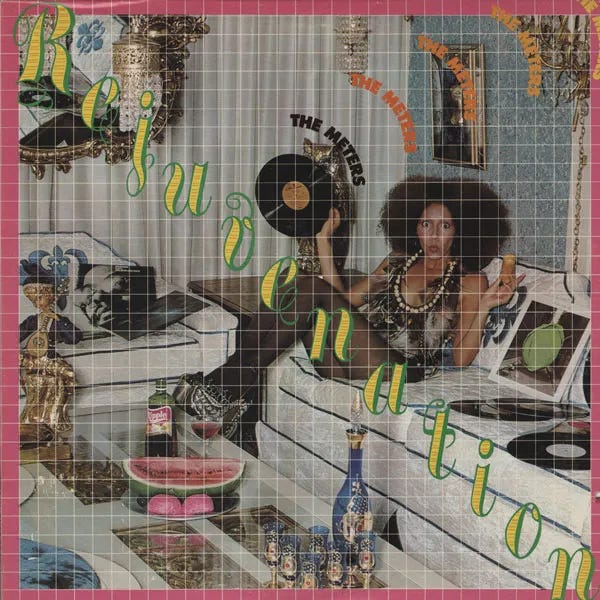Genre of the Day - New Orleans R&B
Album of the Day - Rejuvenation by The Meters (1974)
May 13, 2024
We return to the state of Louisiana and its rich musical heritage for the second time in a week. I considered skipping this genre and going to another random genre because of over-proximity. However, as I said in the last article, I feel nostalgic for the last time I was in New Orleans almost exactly two years ago for my sister’s graduation. As this column has approached over four months, I thought I’d run out of things to say, especially for similar genres. I haven’t had the time to significantly go out of my way to improve my writing skills, or even my musical knowledge beyond the individual research on each genre. Nevertheless, it’s been cool to see the connections between the genres and their significance over time, so it’s fun when they overlap so closely to each other—I find I have even more to say.
New Orleans R&B and zydeco both help highlight two of the most important aspects of Louisiana’s cultural heritage. In zydeco, we saw the strong influence of the far-flung Cajuns who came down from modern-day Canada a couple centuries ago to escape the British takeover for a French safe haven. Little did they know that wouldn’t last either, but I digress. In New Orleans R&B, we see how the rhythms of the city’s iconic festivities like Mardi Gras are deeply interwoven into the city’s musical soul.
Side note: New Orleans truly will find any reason to celebrate. I recall my sister going to a strawberry festival, a crawdad festival, its famous jazz festival, and many more.
The Meters’ funky brand of R&B is largely defined by its rhythmic distinctions rooted in other NOLA traditions that were key imprints upon jazz and funk. New Orleans is known for the tradition of the Second Line, a Black parade tradition of a band donning bright vestiges and playing busy polyrhythms with a long tradition in the region’s African-American music and ultimately rooted in the music of west Africa. The Second Line features a conglomeration of rhythmic influences driven by the colonial constant transportation of slaves from west Africa and parts of the Caribbean to the city. On weekends, enslaved people would use a brief sliver of autonomy to gather in Congo Square and a variety of regional celebratory traditions mixed into Second Line’s complex rhythmic accumulation.
The snare drummer is the key shaker in this process, improvising and departing from their standard expected accents on the two and the four. James Brown’s rhythmic sense was actually influenced by two New Orleans drummers—funk would not have its characteristic movement without the Second Line. Along with Brown, Ziggy Modeliste of today’s band The Meters was a drummer hailed as a key incorporator of Second Line rhythmic style into the American musical landscape. This short video is a great visual illustration of just how fast he can perform a rhythmic pivot and still form a cohesive groove.
Alongside the other musical talents of The Meters, Modeliste would be invited to form the backing band on tours of musicians of such stature as the Rolling Stones, LaBelle, and Paul McCartney. This album sees them blending their rhythmic sense with the R&B lyrical themes of the time and stamping their place in the history of New Orleans R&B, driving extra emphasis into the rhythm in rhythm n blues. The album opens with the busy breaks of “People Say” as they lyrically pull from a widespread R&B tradition of the time, as we saw on the Stylistics’ eponymous album, of acknowledging the social disarray of the US in the opener. The hit “Just Kissed My Baby” exalts the simple joy of a kiss, with horn flair, wah-wah guitar, and hard-hitting interplay between the snares and the slamming kicks. The insistence of “It Ain’t No Use” is underscored by its lengthy breakdown of dynamic piano, intricate drum groove, and electric guitar weaving together. Once you know to listen for the rhythms, they stand out so much more: I admit that on my first listen, I went in blind and I noticed that all the instrumental parts respond and groove so well together that the rhythmic subtleties are somewhat obscured to an unknowing ear. Listening with greater intention is worth it, though. The rhythmic excellence stakes a potential New Orleans’ bid as the world capital of drumming innovation. If you make it to Mardi Gras, it certainly wouldn’t hurt to prep yourself for some of the Second Line experience with this excellent set.




